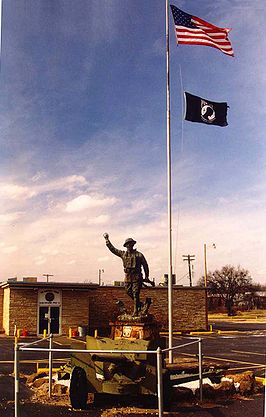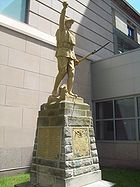
Spirit of the American Doughboy
Encyclopedia

E. M. Viquesney
Ernest Moore Viquesney American sculptor best known for his very popular World War I monument Spirit of the American Doughboy, installed in front of many American city halls and courthouses and in public parks and cemeteries in the years 1920 through 1940...
, designed to honor the veterans and casualties of World War I
World War I
World War I , which was predominantly called the World War or the Great War from its occurrence until 1939, and the First World War or World War I thereafter, was a major war centred in Europe that began on 28 July 1914 and lasted until 11 November 1918...
. Mass produced during the 1920s and 1930s for communities throughout the United States, the statue's design was the most popular of its kind, spawning a wave of collectible miniatures and related memorabilia as well as numerous copies by other artists. Its title is often shortened to "The Doughboy", and in some locales it is nicknamed Iron Mike.
Memorials
The statue depicts a doughboyDoughboy
Doughboy is an informal term for an American soldier, especially members of the American Expeditionary Forces in World War I. The term dates back to the Mexican–American War of 1846–48....
walking through shattered tree stumps strung with barbed wire, his rifle in his left hand and his right hand held high above his head, clutching a hand grenade
Hand grenade
A hand grenade is any small bomb that can be thrown by hand. Hand grenades are classified into three categories, explosive grenades, chemical and gas grenades. Explosive grenades are the most commonly used in modern warfare, and are designed to detonate after impact or after a set amount of time...
. The aggressive design and affordability of the statue made it extremely popular, and more than 150 copies of it were created for municipal memorials across the nation. The Smithsonian American Art Museum
Smithsonian American Art Museum
The Smithsonian American Art Museum is a museum in Washington, D.C. with an extensive collection of American art.Part of the Smithsonian Institution, the museum has a broad variety of American art that covers all regions and art movements found in the United States...
currently lists 159 locations. Of that number, 134 currently existing originals have been independently authenticated, and several have been identified as copies by other artists. Viquesney's actual brochures quoted a figure of over 300 by the late 1930s, claiming at least one in every state of the Union, but this is believed to be an inflated figure.
Two of the statues, both in Arkansas
Arkansas
Arkansas is a state located in the southern region of the United States. Its name is an Algonquian name of the Quapaw Indians. Arkansas shares borders with six states , and its eastern border is largely defined by the Mississippi River...
, are individually listed on the National Register of Historic Places
National Register of Historic Places
The National Register of Historic Places is the United States government's official list of districts, sites, buildings, structures, and objects deemed worthy of preservation...
; one in Helena
Helena, Arkansas
Helena is the eastern portion of Helena-West Helena, Arkansas, a city in Phillips County, Arkansas. As of the 2000 census, this portion of the city population was 6,323. Helena was the county seat of Phillips County until January 1, 2006, when it merged its government and city limits with...
and one in Fort Smith
Fort Smith, Arkansas
Fort Smith is the second-largest city in Arkansas and one of the two county seats of Sebastian County. With a population of 86,209 in 2010, it is the principal city of the Fort Smith, Arkansas-Oklahoma Metropolitan Statistical Area, a region of 298,592 residents which encompasses the Arkansas...
. Installed in cemeteries, town squares, outside museums, parks, on courthouse lawns, and countless other places, the design is said to be the most-viewed example of outdoor statuary in the US (after the Statue of Liberty
Statue of Liberty
The Statue of Liberty is a colossal neoclassical sculpture on Liberty Island in New York Harbor, designed by Frédéric Bartholdi and dedicated on October 28, 1886...
) although many people do not even realize they have seen it.
In 1998, longtime Sarasota-resident sculptor Frank Colson was commissioned to create a copy for the city of Sarasota, Florida
Sarasota, Florida
Sarasota is a city located in Sarasota County on the southwestern coast of the U.S. state of Florida. It is south of the Tampa Bay Area and north of Fort Myers...
, and again in 2002, for the city of Columbia, South Carolina
Columbia, South Carolina
Columbia is the state capital and largest city in the U.S. state of South Carolina. The population was 129,272 according to the 2010 census. Columbia is the county seat of Richland County, but a portion of the city extends into neighboring Lexington County. The city is the center of a metropolitan...
. These were new copies in their own right, not meant to replace any existing Doughboys as Sarasota never had an original Viquesney Doughboy. An original does exist in another part of Columbia, SC, giving that city two; an original and a copy. Colson and his son also worked on the restoration of the Doughboy in Clearwater, Florida
Clearwater, Florida
Clearwater is a city located in Pinellas County, Florida, US, nearly due west of Tampa and northwest of St. Petersburg. In the west of Clearwater lies the Gulf of Mexico and in the east lies Tampa Bay. As of the 2000 census, the city had a total population of 108,787. It is the county seat of...
, along with its companion statue, Spirit of the American Navy.
The original "Doughboy" statue was completed in 1921 while Viquesney was living in Americus, Georgia
Americus, Georgia
-Early years:Americus, Georgia was named and chartered by Sen. Lovett B. Smith in 1832.For its first two decades, Americus was a small courthouse town. The arrival of the railroad in 1854 and, three decades later, local attorney Samuel H. Hawkins' construction of the only privately financed...
and is located in Nashville, Georgia
Nashville, Georgia
Nashville is a city in Berrien County, Georgia, United States. The population was 4,697 at the 2000 census. The city is the county seat of Berrien County...
. However, it was the second to be installed, and about the 25th to be formally dedicated. The first completed installation was at Furman University
Furman University
Furman University is a selective, private, coeducational, liberal arts college in Greenville, South Carolina, United States. Furman is one of the oldest, and more selective private institutions in South Carolina...
in Greenville, South Carolina
Greenville, South Carolina
-Law and government:The city of Greenville adopted the Council-Manager form of municipal government in 1976.-History:The area was part of the Cherokee Nation's protected grounds after the Treaty of 1763, which ended the French and Indian War. No White man was allowed to enter, though some families...
. The statue in Spencer, Indiana
Spencer, Indiana
Spencer is a town in Washington Township, Owen County, Indiana, United States. The population was 2,217 at the 2010 census. It is the county seat of Owen County.Spencer is part of the Bloomington, Indiana Metropolitan Statistical Area.-Geography:...
, the sculptor's hometown, was not dedicated until May 29, 1927.
Statuettes
The statue also sparked an interior decorating fad in the 1920s. The design was so popular that Viquesney manufactured replica pot metalPot metal
Pot metal, also known as monkey metal, white metal or die-cast zinc, is a slang term that refers to alloys that consist of inexpensive, low-melting point metals used to make fast, inexpensive castings....
statuettes by the thousands. Also available were doughboy lamps, which were made from the 12" statuettes (the doughboy held a light bulb and lampshade in his raised hand), candlesticks, plaques, a smaller 6" version of the statuette, as well as less expensive plaster versions. The statuettes and lamps were made from 1921 to 1925 in Americus, Georgia, and continued to be produced in Spencer, Indiana until at least the late 1930s. With the passage of time and changes in fashion, many of these items were lost, broken, or discarded, making those few remaining in good condition sought after by modern collectors.
Variations on the theme

The only stone version of the "Spirit of the American Navy" is found in Crowell, Texas according to a Nov. 2, 2011 article by Daniel Walker in The Vernon Daily Record.
The Smithsonian lists only six under the correct title (the seventh being listed along with the doughboy at Kingman, Arizona
Kingman, Arizona
Kingman is located in a desert climate on the edge of the Mojave Desert, but its higher elevation and location between the Colorado Plateau and the Lower Colorado River Valley tempers summer high temperatures and contributes to winter cold and rare snowfall. Summer daytime highs reach above 90 °F ...
). One, located in Palatka, Florida, is actually a different version of the statue said to have been created by sculptor Ray Fernandez, although no reference to any sculptor by that name exists in either the Smithsonian Art Inventories Catalogue or the AskART.com database. Viquesney's 1936 list shows "2 Doughboys, 2 Sailors", reinforcing the likelihood that Viquesney's "2+2" brochure claim was a typo, since all four statues (the two "standard" Doughboys, the "Sailor", and a variant design Doughboy), were all dedicated at Palatka on November 11, 1927, according to newspaper articles. A Smithsonian reference to the Palatka variant Doughboy states that it may possibly have been sculpted by Gutzon Borglum. There is no proof of this, although Viquesney's self-written obituary boasts that "he knew Borglum".
Other variants were designed by Viquesney to depict different doughboy poses, but very few got past the drawing stage and none were ever realized at full scale. The largest variant actually known to be by Viquesney is a unique three-foot memorial in Lakemore, Ohio
Lakemore, Ohio
Lakemore is a village in Summit County, Ohio, United States. The population was 2,561 at the 2000 census. It is part of the Akron Metropolitan Statistical Area.-Geography:Lakemore is located at ....
, also listed as The Spirit of the Doughboy by the Smithsonian. It was copyrighted in 1930 and dedicated in 1938. No full-sized Viquesney doughboys in any pose other than the original have been confirmed to exist. New information and photographs confirm this piece is actually titled Resting Doughboy and was copyrighted in 1936.

